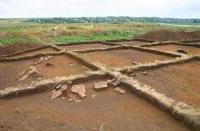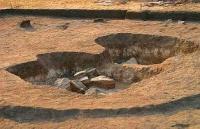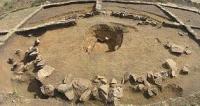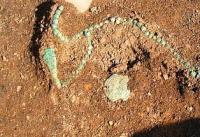You are here
Lisakovsky burial grounds and burial mounds.




Archaeological tours across Kazakhstan.
“You are a shard, having found, wash
And boldly put it on the shelf.
That is a cast of eternity itself,
No end, no limit."
E. Vinokurov.
Excursion around Lisakovsk.
Even at the beginning of the 1st millennium BC, the local tribes inhabiting the steppes of Eurasia developed closeness to each other in a number of parameters of material culture and ideology, developed their own unique material and spiritual values.
The steppes, stretching in a continuous belt, became a large transport road connecting the east and west. Scientists now consider this world as a single historical and integral formation, calling it the "Scythian-Siberian world".
Thus, the natural and geographical environment was the factor that to a large extent contributed to the formation of the cultural and historical unity of the early nomads. Certain types of weapons were developed and distributed among the nomadic peoples - various forms of arrowheads, a dagger with a short blade, horse harness, bronze objects covered with gold foil with images of stylized animals.
Bronze mirrors, beads, Celts have a single form. The rapprochement of the material and spiritual culture of the tribes is also revealed in a complex mythological system, reflected primarily in the funeral rite and art of the style, called "animal".
Common cults are formed: ancestors, sun, fire, animals. The images of animals were the main ones in the visual work of the Sakas, Scythians, Sarmatians, the tribes of Altai, Tuva, Eastern Mongolia and Ordos. The Eurasian steppe was an artery connecting the civilized centers of the Eurasian continent: Western European (Greece, Rome), Central Asian (Mesopotamia, Eastern Mediterranean, Eastern China).
It was a kind of space for the movement and mixing of innovations, cultures, languages and religions.
The contribution of nomadic peoples to world civilization is undoubtedly great, but it is still poorly studied, poorly known, and therefore only becomes the property of world science. And that is why what is happening now not far from the city of Lisakovsk, that is, literally “close by”, is so important for our understanding.
Lisakovsk is a young city. This year he turned 38 years old. However, not far from the city beach, on the banks of the Tobol River, a Bronze Age settlement was found - the remains of dwellings, ceramics, tools, water supply and sanitation systems.
3500 years ago tribes of the Andronovo culture lived here. Episodes from the life of the “ancient Lisakovites” have been restored thanks to excavations that have been conducted by the Lisakovsk archaeological expedition for 25 years.
It all started after one of the local boys discovered fragments of pottery in the cliff of the river bank. It is noteworthy that the archaeological research was carried out by the Karaganda archaeologists. They were started by Viktor Varfolomeev, and from 1985 to the present day the Lisakovsk archaeological expedition has been headed by Emma Usmanova from Karaganda.
Thanks to her work, many unique discoveries were made, including those that could glorify our region on a global scale. During the work of the expedition, not only the settlement of Lisakovskoe was excavated, but also more than a hundred mounds of the Bronze Age.
All findings of the expedition are kept in Lisakovsk, in the Museum of History and Culture of the Upper Pre-Tobol region. By the way, it was the archaeological excavations that prompted the creation of this museum.
More details about the exhibits and the history of the creation of the local history museum in Lisakovsk can be found by visiting the site of the city administration, in the "Museum" section.
Authority and photos:
https://www.allib.org/ru/node/123







